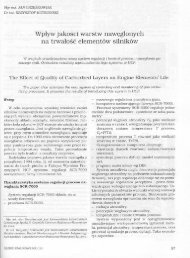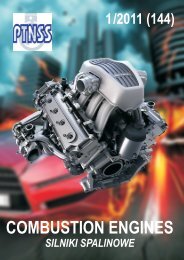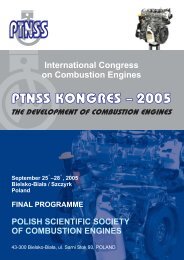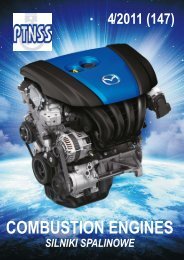Create successful ePaper yourself
Turn your PDF publications into a flip-book with our unique Google optimized e-Paper software.
Możliwości spełnienia norm emisji Euro 6 przez obecnie produkowane europejskie lekkie pojazdy...<br />
Fig. 13. NO x<br />
emissions from the UDC and EUDC phases and from the<br />
entire NEDC cycle for the vehicle fuelled with petrol and CNG in turn<br />
Rys. 13. Emisja NO x<br />
w trakcie faz UDC i EUDC, a także całego cyklu<br />
jezdnego NEDC dla pojazdów zasilanych alternatywnie CNG i benzyną<br />
well as in the complete NEDC cycle, mainly no doubt due to<br />
the lower carbon fraction found in CNG than in petrol.<br />
The main component of natural gas is methane, which,<br />
consisting of one carbon atom and four hydrogen atoms,<br />
has a H/C ratio of 4:1. Other combustible trace components<br />
are somewhat less hydrogen-rich, but the four next most<br />
abundant species typically present in commercial vehicle<br />
fuel natural gas (1) all have H:C ratios ≥ 2.4:1. Assuming a<br />
minimum CH 4<br />
content of 90 per cent, NG can be assumed<br />
to have a minimum H/C ratio of around 3.85:1. In contrast,<br />
petrol has a much lower ratio of 1.86:1. Emission of CO 2<br />
is<br />
a function of fuel consumption, as well as fuel H:C ratio, and<br />
using a fuel with a higher H:C ratio does not always guarantee<br />
reduced CO 2<br />
emissions, but for the for the vehicle used<br />
in this study the resulting effect was significantly reduced<br />
CO 2<br />
emissions. While the Euro 6 regulations do not cover<br />
CO 2<br />
, this finding is of note, as vehicles meeting the Euro 6<br />
standard will also have to comply with other pieces of EU<br />
legislation governing fleet average CO 2<br />
emissions.<br />
4. Conclusions and summary<br />
The main aim of this paper was to determine the influence<br />
of CNG fuel on emissions in the context of the new Euro<br />
6 emissions requirements. An analysis was performed on a<br />
Euro 5 bi-fuel light duty vehicle in comparison to emissions<br />
when the vehicle was fuelled with gasoline.<br />
On the basis of the analyses of results obtained during<br />
the NEDC emissions test, it has been found that the<br />
vehicle tested with a CNG multipoint gas injection and<br />
an integrated (petrol/CNG) ECU already meets the Euro<br />
6 emissions limits, without any further modifications, in<br />
particular:<br />
1. CO, THC and NMHC emissions meet Euro 5/6 limits for<br />
the LDV category. Observed THC emissions were even<br />
relatively close to the NMHC limit stipulated by these<br />
regulations, so emissions limits in this area were comfortably<br />
met. NMHC emissions were almost 50% under the<br />
Euro 6 limit when running on CNG.<br />
2. THC emissions during the NEDC cycle increased when<br />
the vehicle was fuelled with CNG, in comparison to petrol,<br />
but this increase was far too small to cause problems with<br />
the Euro 6 emissions limit.<br />
Fig. 14. Tailpipe NO x<br />
concentration during the NEDC cycle for the vehicle<br />
fuelled with petrol and CNG in turn<br />
Rys. 14. Stężenie NO x<br />
w spalinach podczas cyklu jezdnego NEDC<br />
dla pojazdów zasilanych alternatywnie CNG i benzyną<br />
azotu. Inny proces generalnie wymaga wysokich temperatur,<br />
a zatem lokalizacja obszarów wysokich temperatur<br />
(miejsc gorących) ma znaczący wpływ na formowanie się<br />
NO x<br />
[4]. Ewidentnie mniejsza emisja NO x<br />
, prezentowana<br />
wyżej, może być częściowo spowodowana lepszą termalną<br />
jednorodnością w cylindrze (wyższa średnia temperatura,<br />
ale mniej miejsc „gorących”) podczas zasilania pojazdu<br />
gazem CNG. Zaobserwowaną redukcję w emisji NO x<br />
podczas<br />
obu faz cyklu jezdnego dla silnika zasilanego CNG<br />
można wytłumaczyć lepszym mieszaniem się powietrza z<br />
paliwem gazowym.<br />
Emisja CO 2<br />
Na rysunkach 15 i 16 przedstawiono wyniki emisji CO 2<br />
zarówno dla CNG, jak i benzyny. Można zauważyć, iż ta<br />
emisja jest o około 24% mniejsza dla paliwa CNG niż dla<br />
benzyny w obu fazach testu jezdnego, jak również w kompletnym<br />
cyklu NEDC, z powodu mniejszej zawartości węgla<br />
(C) w gazie ziemnym w porównaniu do benzyny.<br />
Głównym składnikiem gazu ziemnego jest metan, który<br />
zawiera jeden atom węgla i 4 atomy wodoru, posiada stosunek<br />
H/C o wartości 4:1. Inne palne, śladowe składniki są<br />
raczej uboższe w wodór, ale kolejne cztery o największym<br />
udziale w składzie gazu ziemnego, jako paliwa dla pojazdów<br />
samochodowych, posiadają stosunek H/C ≥ 2.4:1. Gdy<br />
założy się minimalną zawartość CH 4<br />
na poziomie 90%, gaz<br />
ziemny może mieć przewidywany minimalny stosunek H/C<br />
na poziomie 3.85:1. Dla porównania: benzyna czy olej napędowy<br />
zasadniczo mają niższe stosunki H/C – odpowiednio<br />
1.89:1 i 1.86:1. Emisja CO 2<br />
jest funkcją zużycia paliwa, a<br />
także stosunku H:C. Wykorzystanie paliwa o większym<br />
współczynniku H:C nie zawsze gwarantuje redukcję CO 2<br />
,<br />
jednak dla pojazdu wykorzystanego w tym teście emisja<br />
CO 2<br />
była mniejsza. Pomimo tego, że wymagania Euro 6 nie<br />
regulują kwestii poziomu emisji CO 2<br />
, to warto zauważyć, że<br />
pojazdy spełniające tę normę, będą musiały spełniać inne europejskie<br />
wymogi dotyczące średniej emisji flotowej CO 2<br />
.<br />
4. Wnioski i podsumowanie<br />
Głównym celem niniejszej pracy było określenie wpływu<br />
zastosowania paliwa gazowego CNG na emisję szkodliwych<br />
składników spalin silnikowych w aspekcie nowych<br />
przepisów emisyjnych Euro 6. Analizę przeprowadzono z<br />
30 <strong>COMBUSTION</strong> <strong>ENGINES</strong>, No. 4/2012 (151)












